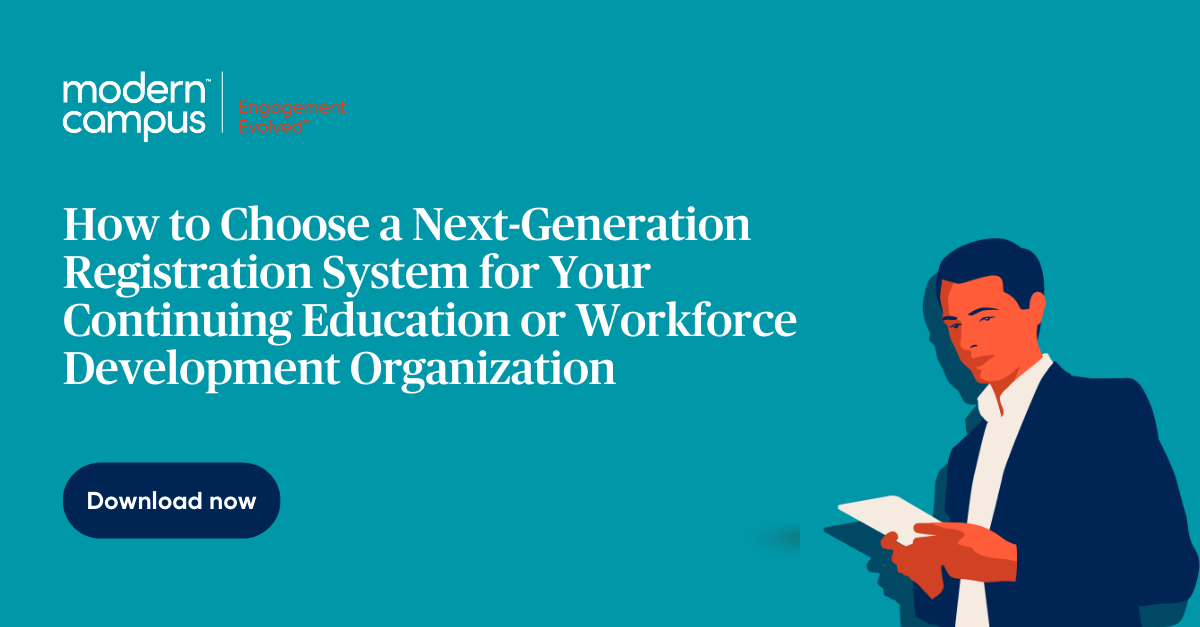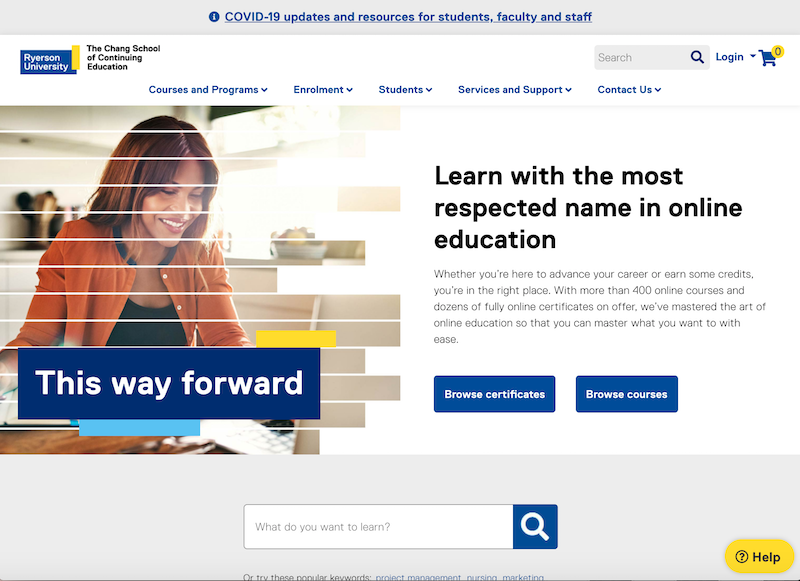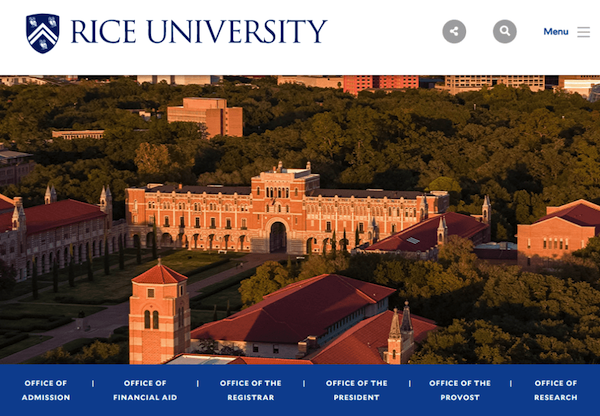
f
Higher education is experiencing a “sink or swim” moment. Enrollments in traditional programs continue to plunge, leaving many schools at a loss for the vital revenue and resources they need to continue providing value-add education while growing the institution’s revenue. And increasingly, students aren’t seeing their needs reflected in institutional offerings or outcomes.
Despite the majority of students enrolling in higher education to find a pathway to a career, 43% of college graduates are underemployed in their first job. So the enrollment dip isn’t being driven by circumstances alone. Through a pandemic and historic recession—which created high unemployment that generally increases enrollment numbers—students began looking for alternative, non-degree approaches to postsecondary education. Offerings that met their need for relevant, flexible and work-focused education.
There’s also a business imperative for the modern campus to adapt to these changing circumstances with agile programming and delivery methods. Given recent revenue losses from declining enrollments, combined with the long-term trends of declining public appropriations to higher education (a trend likely to continue), it’s become essential for postsecondary institutions to find ways to deliver market-responsive programming to increasingly diverse audiences of prospective students.
The COVID-19 pandemic accelerated a trend that many institutions weren’t prepared to manage: A shift towards the digital education delivery model that is now the norm. It’s easy to point a finger at the pandemic, but higher education has been slow to adapt well before COVID-19. The inflexible student management system that plagues higher education is why so many units have found difficulty pivoting to a delivery model that successful online businesses have long since honed.
Download Whitepaper
Modern Administration Needs Student Management Systems that Reflect Modern Commerce
Today’s eCommerce giants have their back-end down to a science. They’re revenue-generation machines, with every step of their transactions built for minimal consumer friction. They’re built for self-service: Customers direct their transactions without need for support, in as few clicks as possible.
Continuing and workforce education units would benefit from applying this to their own environment. Because when they don’t, the student experience suffers. 44% of American students said they would’ve had a better experience if they could interact digitally with their university. Internationally, nearly 50% of respondents expected administration to be easier to manage, given the fees they pay for a postsecondary education. A third of students were frustrated with how complex institutional processes and paperwork are.
Considering the astronomical rate of shopping cart abandonment that follows most online shopping experiences, it’s no surprise so many institutions are seeing losses in tuitions and learner engagement.
Today’s most successful eCommerce student management systems have four major components, each of which is executed to be as customer-centric as possible:
- Self-Service Digital Engagement
- Expansive Conversion Points
- Lifelong Customer Retention
- Personalized Engagement
All of these are applicable to non-credit education units, and all are an absolute necessity for growing Continuing Education and Professional Development.
Higher education has been cautious about thinking of students as customers, but it’s clear that they’re behaving like customers. They hold the same expectations for an institution vying for their enrollment as they do when browsing Amazon: They expect to be able to serve themselves. As with GrubHub or Uber, they anticipate that they can carry out every step of the process without need for a third party.
Higher Education Student Management Systems are Not Built for Self-Service
When learners face difficult administration processes, they simply walk away. There’s a number of factors that will drive students to other education providers: an unintuitive website, difficult-to-find courses, outdated program information and tedious checkout processes top the list for a modern consumer.
Before we brought in Destiny One, students sometimes had to wait two or three days to register. We analyzed this process and found that we were losing a significant number of enrollments because of the wait time for learners.
For many postsecondary institutions, COVID-19 resulted in immediate dropouts and stop-outs, and translated to significant enrollment loss for spring and summer terms. Ryerson University’s Chang School of Continuing Education may not have been prepared to adapt to the crisis if not for their use of Destiny One, a next-gen student management system that allowed them to meet the market’s demand for an accessible and intuitive digital experience.
Fred Anger, Executive Director of Financial Planning and Strategy for the Chang School, said prior to modernizing their administration processes, students would drop off when they couldn’t access key program information or enroll without staff intervention.
“Before we brought in Destiny One, students sometimes had to wait two or three days to register,” Anger said. “We analyzed this process and found that we were losing a significant number of enrollments because of the wait time for learners.”Let Students Manage Their Administration
There is no band-aid for a poor digital experience. You have to develop a good one, that streamlines and simplifies the learner experience through clear and intuitive digital design.
Destiny One helped the Chang School benefit from the same self-service principles that eCommerce giants like Amazon and Uber are known for. Serena Wong, Manager of Business Systems at the Chang School, said the system simplified and centralized all program and course information, and transformed the unit’s web presence for easy navigation for all learners.
“We had one staff member who spent three hours with one individual senior helping them enroll using our old website,” Wong said. “When we were piloting Destiny One, we had one senior come in and try enrolling for a course using our new system to test its effectiveness before it went live. They were so surprised by how quick and easy it was to register with Destiny One,” Wong said.
Anger said visitors to the school’s site are staying longer than ever, which also supports their conversion rates.
“Now we're seeing a much deeper penetration into the website, and students staying longer,” Anger explained. “In the year before Destiny One, they visited four pages per session. Now it's trending towards six. That’s almost a 33% increase in web engagement.”
More Self-Service, More Enrollments
In 2019, the Chang School processed 28,000 course enrollments for 15,600 students. In 2020, despite the pandemic, the Chang School is on-track to process over 30,000 course enrollments for 16,000 students. Anger attributes much of this growth to the school’s use of Destiny One.
“Using Destiny One in the 2020 spring-summer term, we experienced a total enrollment growth of 10%,” Anger said. “Our CE enrollment is driving our growth. The Destiny product puts us up over 17% in enrollments.”
Gary Hepburn, Dean of the Chang School, pointed to a self-directed student experience as key to their ability to weather and profit throughout changing times.
“Despite losing 60% of our business a little over a month ago because of COVID-19, we've gained it all back. In fact, we think we're going to exceed our business from last year.”
Using Destiny One in the 2020 spring-summer term, we experienced a total enrollment growth of 10%. Our CE enrollment is driving our growth. Destiny One puts us up over 17% in enrollments.
Adapting to Crisis and Preparing for Growth
Learn how the Chang School at Ryerson University is leveraging Destiny One

One of the best things about modern commerce is the increase in opportunities to convert a prospect into a customer. The biggest names in eCommerce recognize that there are many points before, during and following a transaction to continue selling a visitor on other offerings that may enrich their experience.
Enrollment is Not the Only Point of Sale
Many institutions don’t take account for the numerous chances to keep a learner engaged with their offerings, and work within systems that treat the “register” button as the only potential point of sale.
Kara Eldersveld, Director of Marketing & Enrollment Strategy at the Susanne M. Glasscock School of Continuing Studies at Rice University, said the lack of integration between the school’s administration system and its marketing processes meant they had little insight into where else they might be able to connect learners with their offerings.
Increase Opportunities to Turn Prospects into Enrollments using a Modern Student Management System
There are many ways to win a learner’s heart with your programming, but they first need to be guided to it.
According to Eldersveld, integrating their marketing systems with Destiny One showed them new data that shed light on the many points throughout their conversion funnel where they could continue to promote their offerings.
Having that visibility has allowed us to really build out a much more optimized marketing strategy of how we connect with our users.
“From a marketing perspective, we've been able to gain full visibility into our conversion funnel,” Eldersveld said. “We know how many times the users go to our website, what channels the users came from what content they viewed for each of their sessions. If it's organic search, paid search, direct.”
Eldersveld said the modernized administration system also shows when the user enrolled.
“Having that visibility has allowed us to really build out a much more optimized marketing strategy of how we connect with our users.”
For learners who’ve shown interest in a course that’s full or unavailable, the modern eCommerce system keeps them engaged. With Destiny One, if a student gets to a landing page for a course or program that is full or isn’t being offered, the next-generation registration system uses a “remind me” functionality when a program isn’t available to tag students back in, and automates program and course waitlists when they’re full.
Attracting and Engaging Students with Destiny One
Maximizing the Value of the Tech Stack through Key Integrations at Rice University’s Glasscock School of Continuing Studies

Many Points of Conversion, Many Points of Sale
Eldersveld said Destiny One’s ability to expand Rice’s points of conversion has allowed them to capture what would otherwise be lost leads.
“Using Destiny One last spring, even with COVID-19, we had our best enrollment period. That’s attributed to Destiny One’s integration, and we wouldn’t have that visibility without it,” Eldersveld said. “We saw an increase of enrollments of about 35%.” Eldersveld said the software has opened many opportunities to upsell, especially with the ability to enroll students into bundled courses.
Carolyn Young, Director of Continuing Studies at Western University, noticed a sizable increase in enrollments when using Destiny One to reach students that might otherwise have been lost through automated reminders.
“After Destiny One sent the automated emails for the first time, 25 percent of the recipients signed up for courses right away,” Young recalled.
After Destiny One sent the automated emails for the first time, 25 percent of the recipients signed up for courses right away.
The best modern eCommerce systems are built to form mutually-beneficial relationships with customers, providing lifelong value to the consumer and perpetual revenue for the business. Very few Amazon users have only made a single purchase through the online retail giant, and it’s because they wring every opportunity to continue engaging those users after a purchase has been made.
Get Away from One-and-Done Enrollments
If your relationship with students is transactional, and focused on one-time programs before sending learners on their merry way, you might have a learner engagement gap.
Robin Sease, a Senior Business Analyst at UC Berkeley Extension, said the school’s historic model of engagement was one-dimensional and limiting.
“Our ancient system was a transactional system so each time a student enrolled they created a new entry in the system. They didn’t really have an account, they just provided whatever information about themselves that they wanted to in order to register for the offering,” Sease said. “There was no transcript compilation either, so if a student asked for a transcript the staff had to find all of the student’s entries—which were potentially under different names, different addresses—and manually create a transcript.”
Sease said these processes didn’t lend themselves to the supportive, learner-first culture that UC Berkeley needed to retain learners after they’d completed a program—and that the school needed to deliver on the promise of its brand.
Keep Engaging Successful Learners with a Modern Student Management System
When a system prioritizes lifelong student retention, it can keep a learner engaged well after a course or program has been completed; with the potential for decades-long relationships that both student and institution benefit from.
The biggest piece of UC Berkeley’s transformed student experience is Destiny One’s Student Portal: a self-service portal that allows learners to engage with UCBX on their own terms. Aside from letting students enroll in courses, request transcripts, review their historical financial information and otherwise grant full visibility to their academic experience, the system also collects and retains vital historical learner information that gives the school’s marketing team a leg up when they want to re-enroll successful students.
“With the Student Portal, we significantly improved our student experience, and that has made a difference for re-enrollment,” Sease said.
Secure Learners and Revenue for Life
Now able to better serve their existing students, staff and leadership at UCBX have begun finding ways to grow their reach without needing to seek and build new customer relationships. Instead, they’re leveraging Destiny One to expand their existing offerings and improve re-enrollments of existing students—developing student-institution relationships that will keep them engaged for years to come.
The modern student is a consumer, which means the modern campus has to think like a business. In the age of Amazon and “related searches”, learners have come to expect a level of personalization when dealing with any service online.
Learners Are More Than a Number
Too many institutions miss out on the chance to make a connection with what their learners want, even when what they “want” can be quickly deduced through their interactions and history with an institution.
It’s not only important to make sure that the user experience allows students access to offerings, but it’s equally necessary to retain students who have already moved through the registration process.
Chris Moir, Executive Director of College Hospitality Services & Retail Operations at Cuyahoga Community College (Tri-C), said this requires a level of personalization that wasn’t always possible using the school’s outdated tech administration system.
“You can eliminate all the barriers to come in, but we also need to focus on persistence and attainment,” Moir said.
Show Learners What They Came For
Learners are customers, and thrive when engagement is carefully curated to their preferences and experiences. In higher education, this means an online experience that reflects prior purchases or interactions with a school’s web page. When done well, content tailored to specific learners can drive engagement, enrollment and revenue.
Moir said implementing Destiny One has helped them create a tailored experience for prospective and existing students using data collected by the next-gen administration software.
“Say we have a certificate that’s composed of 10 courses. If someone takes one or two courses, we can see in the system that they haven't taken the other eight,” Moir proposed. “We can contact those students and let them know there’s more offerings on the horizon that can help them meet their goals.”
Moir said this and other modes of personalized access to Tri-C’s access directly support the school’s revenue goals.
In less than six months, we’ve seen an increase in the number of students that are registering online using Destiny One. That’s an early positive indicator.
Personalized Experiences Turn Visitors into Students
Corporate College at Cuyahoga Community College (Tri-C) have exploded their enrollments in non-credit programming with Destiny One’s superior student experience, much of which is due to the personalized experience the system employs. Within the first six months live with Destiny One, Tri-C Corporate College President and CEO Robert Peterson said Tri-C increased enrollments by 16 percent, while also boosting online registration by 52%.
“In less than six months, we’ve seen an increase in the number of students that are registering online using Destiny One,” said Peterson. “That’s an early positive indicator.”
Better Systems Mean Better Experiences and Revenue
The most successful modern eCommerce systems are ones that place the consumer first. They’ve built every administrative process around whatever will make their visitor’s journey seamless, from the first click onward. They simplify the student experience to be accessible to learners from all walks of life, and as easy as they’ve come to expect from their online interactions most everywhere else.
With a modern eCommerce system, an institution can not only survive, but thrive in this new era for higher education with expanded market reach and learners that remain perpetually involved with the institution.
Destiny One Student Lifecycle Management
Learn how Destiny One can grow enrollments, increase revenue and expand your institution with data that supports divisional growth.
About Modern Campus
Modern Campus, the innovator driving Omni CMS and Destiny One, empowers higher ed institutions to thrive when radical change is required to deal with lower student enrollments and revenue, rising costs, crushing student debt and even school closures.
Powered by the industry’s only “student first” modern learner engagement platform, presidents and provosts can create pathways for lifelong learning, and marketing and IT leaders can deliver Amazon-like personalization and instant fulfillment.
Award-winning products and an exceptional customer experience for its 550+ higher ed customers and more than 6.7 million students engaged with its platform have earned Modern Campus a reputation for customer obsession – symbolized by its 99% customer satisfaction rating and 98% retention rate.
Learn how Modern Campus is leading the Modern Learner Engagement Movement at www.moderncampus.com.
Download Whitepaper
Related Resources

Guide
How to Choose a Next-Generation Registration System for Your Continuing Education or Workforce Development Organization
Non-traditional education demands a non-traditional student information system (SIS). Does your SIS meet the unique needs of your non-credit unit?

Whitepaper
Applying Student Lifecycle Management Fundamentals to Higher Education
Learn how student lifecycle management fundamentals can be applied to your institution.

Blog
4 Keys to Engaging the Modern Learner
Learn how to deliver the experience modern learners expect with a modern campus.